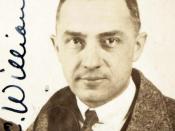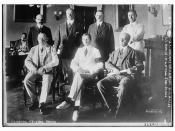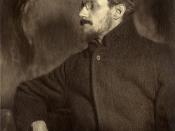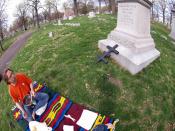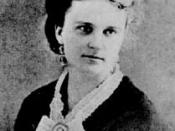The Successful Capturing of Real Life Are you a writer? If so, do you ever have trouble when writing short stories? I have once felt that when writing short stories I have to write about "un-lifelike"ÃÂ situations, using uniquely different characters to fulfill the meaning of writing a "fiction"ÃÂ story. After reading four different short stories by Kate Chopin, William Carlos Williams, Toni Cade Bambera, and James Joyce, I have come to the conclusion that, in the hands of a good fiction writer, "real life"ÃÂ can very successfully be captured within the "art"ÃÂ of the story. I have used the literature aspect of character to prove my point about the four stories I read. I hope you can see just how well a character can bring out the "real life"ÃÂ in a fictional story. I also hope that you will be influenced to create characters that relate to "real life"ÃÂ people in your writings.
Do you feel that by using lifelike characters defeat the meaning of fiction? If you do, I can show you otherwise. I have briefly reviewed each of the four fiction stories explaining how "real life"ÃÂ has been captured through the aspect of character within each story.
Kate Chopin's, "The Story of an Hour"ÃÂ shows character by revealing Mrs. Mallard's true inner feelings about the death of her husband, while all along she is showing different feeling on the outside. "The Use of Force"ÃÂ by William Carlos Williams also describes character by showing how the doctor acts calm and patient in front of his young uncooperative patient and her parents, while he is really having impatient, disturbing thoughts toward the girl. In Toni Cade Bambera's "The Hammer Man"ÃÂ, Manny and the girl act as if they cannot stand one another. Both of their true feelings are revealed when they are put in a troubling predicament. In James Joyce's "Araby"ÃÂ, a young boy feels that he is deeply in love with a girl that he doesn't even know. When the girl uses him to get what she wants, he realizes that his feelings are not love. He sees that he could not love someone so self-centered; and that it was merely lust. Within each of these four stories the author has captured "real life"ÃÂ by using experiences from their own lives and by showing how one's character may be a battle of appearance vs. reality.
Believe it or not, there are "real life"ÃÂ situations that compare to that of the main character in each of these stories. We too may not realize or notice the true feelings of a "real life"ÃÂ character in a particular situation. There really are people who show themselves in a certain perspective, but have true, inner feelings from the opposing perspective. The character's image may have been intended to be fictional; although, it may imitate a real person's image. Chopin's character, Mrs. Mallard, could have been depicted from Chopin's real life, considering that she lost her own husband early in life (Wilson 265). Chopin may or may not have had such cruel thoughts, but either way her ideas for this "fictional"ÃÂ story could have been drawn from her own experience of losing her husband.
Williams' reality in his fictional piece was also captured through his main character in "The Use of Force"ÃÂ, since the man was a pediatrician. The experience the fictional doctor went through may have been drawn from Williams' own personal experiences as children's doctor (Kennedy). Williams may have never experienced the exact situation as the one in "The Use of Force"ÃÂ as a pediatrician, but I do believe that this story could have been written based on a "real life"ÃÂ moment of his.
"The Hammer Man"ÃÂ could have also been written from Bambara's own "real life"ÃÂ experiences, considering that she grew up on the wild side of town. Maybe she was used to seeing events such as the one between Manny, the girl, and the cops.
Like the other three short stories, I think James Joyce successfully captured "life"ÃÂ within the pages of "Araby"ÃÂ. In fact, he even wrote this story relying on scenes from his own boyhood as well. (Litz 79). Given this, it is very clear that the author has captured "real life"ÃÂ within his short story. In fact, it has been captured from his "real life"ÃÂ experiences.
There are also many scenes in each of these stories that show exactly how appearance and reality shadow each other within a character. Chopin's character, Mrs. Mallard, has a heart trouble; but it does not appear to be a problem as she is gently informed of her husband's death. Although, she is devastated at such news. She departs from all of the others to be alone, leading everyone to believe she needs peace in her time of sorrow. At this point, as a reader, you're probably thinking that her reaction is quite normal, very real life like, right? Wrong. While her sister is worrying, trying to convince her to come out of her room and not make herself ill, Mrs. Mallard is whispering, "Free! Body and soul free!"ÃÂ (Chopin, 468) Is this woman an evil, ill-minded creature? I think she enjoys these thoughts because she does not proceed to try to stop them. Like my self, other readers believe, "She is excited by the prospect of beginning her life again after the reported demise of her husband."ÃÂ (Wilson, 265). This could actually be a scene from real life, only in real life we may not hear the thoughts of others. From the way Chopin depicts her main character, I imagine Mrs. Mallard to be self-centered and inconsiderate because of inner feelings of joy at the loss of her husband. She gains sympathy from others by her actions of great sorrow. But really she is more joyful than sad. She acts as if "she was drinking in a very elixir of life"ÃÂ (468). She felt "free, free, free!"ÃÂ (468). This is how she felt after the death of her husband; although, she appeared to be heartbroken.
If you do not think Williams successfully captured real life in "The Use of Force"ÃÂ you might want to reread it. Although most doctors seem to smile as if they love their job, a lot of them have some of the same type of negative thoughts as the main character while dealing with stubborn, uncooperative patients such as Mathilda. The doctor smiles to hide his feelings toward "the savage brat"ÃÂ (Williams 470). His inner feelings worsen as he thinks to himself, "I could have torn the child apart in my own fury and enjoyed it"ÃÂ (471).
I also think Mathilda is a "real life"ÃÂ like character who portrays appearance vs. reality. At first, the child seemed to be very pleasant, quiet, and attractive; but the "uncalled for"ÃÂ split side of her began seeping through as the doctor began to examine her. The child's character is what we would expect from a young, sick child being examined by an unusual man, the doctor. As she begins to go into fits of rage and overreaction the doctor's thoughts about her worsen.
The characters in Bambara's "The Hammer Man"ÃÂ also show real feelings between two characters revealed, although they act as if they merely hate each other. Manny is the crazy boy next door who always picks on the girls and thinks of his self as crazy. The narrator is a free spoken and outgoing tomboy who just can't seem to get along with Manny; therefore, she "was glad to hear that Manny had fallen off the roof."ÃÂ (Bambara, 472) The two just cannot get enough of picking on one another. Until one day the girl is walking past the basketball court after being thrown out of a center for playing pool instead of sewing like a lady. This is when Manny and her meet again. She stops to ask, "what the hell he's doing playing in the dark"ÃÂ. (474) He doesn't say much about it, and neither does she. She just stands there watching him shoot until two cops show up and try to force them to leave. At this point, the true character of Manny and the narrator are shown. The two cops are very rude to the both of them, ordering them to leave the court for no apparent reason. One of the cops even smacks Manny "upside his head"ÃÂ and asks, "Did you hear what I said, black boy?"ÃÂ (474) Both of the main characters feel insulted and angry, having bonded by acting as siblings during this trial of white cops against black teens. They both break down and let their true selves show now. One took up for the other until the cops finally arrested Manny and took him away. Although Manny and the girl appear to dislike each other very much, but the inner feeling of them both come through when they are trying to defeat the cops.
Joyce's character in "Araby"ÃÂ thinks he is completely in love with a girl, but then realizes that love is not what he is feeling. The girl takes advantage of the boy, making him feel as if he should buy her something at the "Araby"ÃÂ. Because of his obsession with her, he doesn't hesitate to do so, hoping that this might impress her or make her like him. Joyce's character thinks he is really in love, yet he is only in lust with this girl. It does not take much for the boy to realize just how blind he is. He is giving her the satisfactory of giving her only what she wants, without his own feelings in consideration. He soon sees the real girl, inside as well as out. He notices himself being driven by her vanity, which makes him very angry. Anyone can see how this story shows how reality vs. appearance. In appearance he is in love, in all reality it is nothing more than lust.
Each of the four authors have captured real life through some point or experience in their own "real life"ÃÂ. It could have been the thoughts of being a real doctor influencing Williams to write his story. Maybe the lifestyle Bambara grew up living inspired her to write her fictional story. Each of the writers have also successfully captured "real life"ÃÂ through showing how much the appearance of people takes over the reality of them. They have shown how people may act sad when they are really filled with joy. They may show how some appear to hate each other, when they really care for each other.
Now you have seen it done. You can relate to each of these stories to see how the usage of "lifelike"ÃÂ characters in fiction writing can be done. I hope you do not feel that just because you are writing a fictional piece, each event and character have to be completely unrealistic. In the hands of a good fiction writer, "life"ÃÂ can be captured in the "art"ÃÂ of a short story. As for the question, "Are you a writer?"ÃÂ let me rephrase that. Are you a good writer?

